Joe Biden visits Lockheed plant as weapons stockpile strained
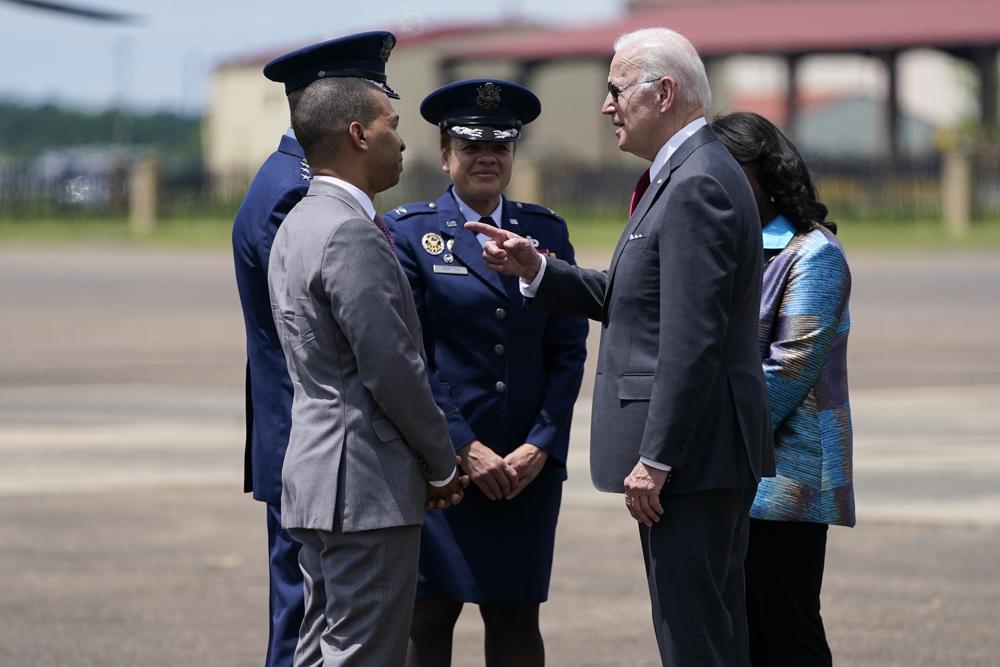
President Joe Biden on Tuesday visited a Lockheed Martin plant that manufactures an antitank weapons system, aiming to herald the U.S.-made arms as a gamechanger for Ukraine’s stiff resistance to Russia’s invasion. But Biden’s visit to the Alabama factory line is also drawing attention to a growing concern as the war drags on: Can the U.S. sustain the cadence in shipping vast amounts of arms to Ukraine while maintaining a healthy stockpile it may need if conflict erupts with North Korea, Iran or elsewhere? The U.S. has provided at least 7,000 Javelins, including some transferred during the Trump administration, or about one-third of its stockpile, to Ukraine in recent years, according to an analysis by Mark Cancian, a senior adviser with the Center for Strategic and International Studies international security program. The Biden administration says it has committed to sending 5,500 Javelins to Ukraine since the February 24 invasion. Analysts also estimate that the United States has sent about one-quarter of its stockpile of shoulder-fired Stinger missiles to Ukraine. Raytheon Technologies CEO Greg Hayes told investors last week during a quarterly call that his company, which makes the weapons system, wouldn’t be able to ramp up production until next year due to parts shortages. “Could this be a problem? The short answer is, ‘Probably, yes,’” said Cancian, a retired Marine colonel and former Office of Management and Budget specialist on Pentagon budget strategy, war funding, and procurement programs. He added that Stingers and Javelins were where “we’re seeing the most significant inventory issues,” and that production of both weapons systems has been limited in recent years. The Russian invasion offers the U.S. and European defense industry a big opportunity to bolster profits as lawmakers from Washington to Warsaw are primed to increase defense spending in response to Russian aggression. Defense contractors, however, face the same supply chain and labor shortage challenges that other manufacturers are facing, along with some others that are specific to the industry. Military spending by the U.S. and around the world was rising even before Russia’s Feb. 24 invasion. Biden’s proposed 2023 budget sought $773 billion for the Pentagon, an annual increase of about 4%. Globally, total military spending rose 0.7% to more than $2 trillion for the first time in 2021, according to an April report from the Stockholm International Peace Research Institute. The war will mean increased sales for some defense contractors, including Raytheon, which makes the Stinger missiles Ukrainian troops have used to knock out Russian aircraft. The company is also part of a joint venture with Lockheed Martin that makes the Javelins. Biden will visit Lockheed Martin’s facility in Troy, Alabama, which has the capacity to manufacture about 2,100 Javelins per year. The trip comes as he presses Congress to quickly approve his request for an additional $33 billion in security and economic assistance for Kyiv. Senate Majority Leader Chuck Schumer, D-N.Y., said Monday he hoped quick bipartisan agreement on the security package could be reached so the Senate could begin considering it “as early as next week.” A White House official, who was not authorized to comment publicly and insisted on anonymity, said the Pentagon is working with defense contractors “to evaluate the health of weapons systems’ production lines and examine bottlenecks” in the manufacturing process. The administration is also considering a range of options, if needed, to boost production of Javelins and Stingers, the official said. Pentagon press secretary John Kirby said Monday that America’s military readiness is not dependent on one system. He said that every time the Pentagon develops a package of weapons and systems to send to Ukraine, the chairman of the Joint Chiefs of Staff and the department do an assessment on what the impact will be on readiness. “It’s not about counting, say, Javelins and being able to say that when you reach a certain level, then all your readiness is gone,” Kirby said. “The Javelin is an anti-armor capability, so we judge it all as a conglomerate of what’s our ability to meet this particular mission set, realizing that a Javelin isn’t the only capability you have against armor.” The lightweight but lethal Javelin has helped the Ukrainians inflict major damage on Russia’s larger and better-equipped military. As a result, the weapon has gained almost mythic regard, celebrated with a Javelin song and images of Mary Magdalene carrying a Javelin becoming a meme in Ukraine. Lockheed Martin CEO James Taiclet said in a recent CNBC interview that demand for the Javelin and other weapon systems would increase broadly over time because of the Russian invasion. He said the company was working “to get our supply chain ramped up.” “We have the ability to meet current production demands, are investing in increased capacity, and are exploring ways to further increase production as needed,” Lockheed Martin, which is based in Bethesda, Maryland, said in a statement. Republished with the permission of the Associated Press.
Joe Biden to visit Alabama weapons plant
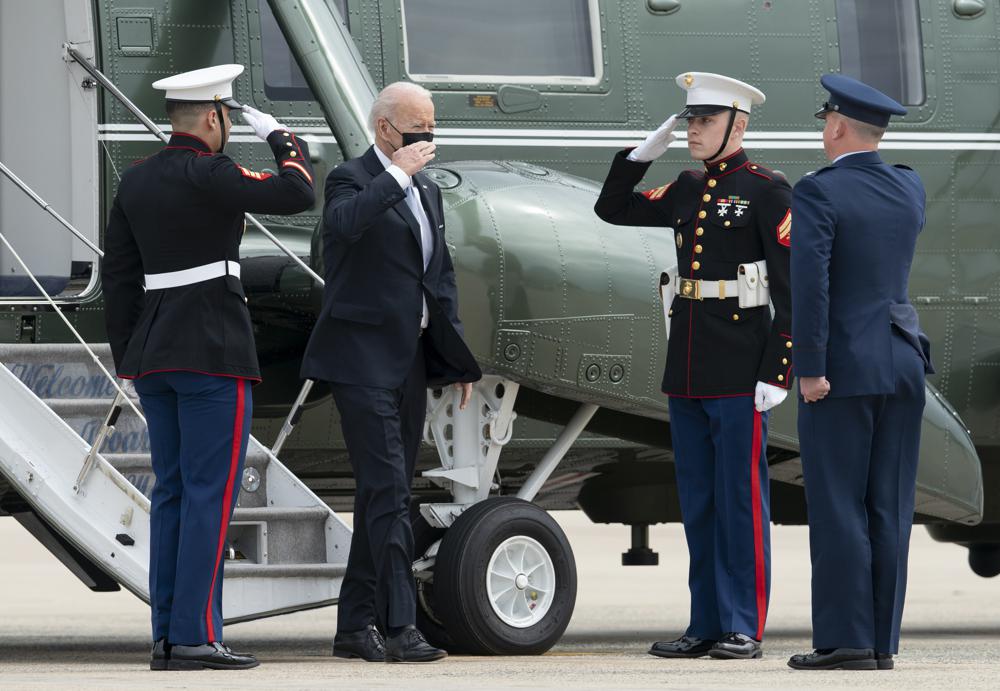
President Joe Biden will tour a Lockheed Martin facility in Alabama that makes weapons systems such as Javelin anti-tank missiles, which the administration is providing to Ukraine to defend itself against Russia’s 2-month-old invasion, the White House said Wednesday. Biden plans to visit the facility at Troy, located south of Montgomery, on Tuesday. The factory has about 600 employees working on a number of different weapons programs, according to the company’s website. A Javelin is a long-range guided anti-tank missile that can be carried by one person. The United States says it has provided several thousand of the systems to Ukraine. Republished with the permission of the Associated Press.
Airbus Alabama facility in line to build tanker aircraft with Lockheed Martin

The Airbus manufacturing facility in Mobile is poised for potential growth, thanks to plans announced Monday by the aerospace company and Lockheed Martin to collaborate on a refueling tanker aircraft if the partners win an Air Force competition. In a news conference at its Alabama facility, Airbus said it would begin building A330 aircraft in Mobile that would be converted into a tanker outfitted for military use at Lockheed Martin’s plant in Marietta, Georgia. Lockheed Martin — which also has a major presence in Alabama — provided details in an announcement released Monday morning. The tanker aircraft, called the LMXT, would represent a significant new chapter for the Alabama Airbus facility, where the company builds A320 and A220 passenger jets. The $1 billion factory at the Mobile Aeroplex at Brookley employs about 1,000 people. “Establishing this production work in Alabama and Georgia confirms Lockheed Martin’s commitment that the LMXT will be built in America, by Americans, for Americans,” said Lockheed Martin Chairman, President and CEO James Taiclet. “The LMXT will strengthen global security by enabling our U.S. service members to carry out their most critical missions at extended ranges. “At home, the LMXT will strengthen job growth and manufacturing by drawing on the experience and talents of a high-tech American workforce in two states that are proven leaders in aviation,” he said. Lockheed Martin and Airbus plan to compete for a new contract from the Air Force for aerial refueling tankers as part of a competition set to begin later this year. “Today’s announcement further cements Alabama’s reputation for excellence in the aerospace industry,” Gov. Kay Ivey said. “We have a world-class workforce making Mobile a top city for manufacturing and innovation, and we are excited to welcome the Lockheed Martin LMXT to Brookley. “This state-of-the-art aircraft is the right plane for the war fighter, and we’re thrilled to have it built in Alabama.” Ivey joined Airbus officials and local leaders at the announcement ceremony at the Brookley facility. Lockheed Martin scheduled a formal announcement at its Georgia facility later in the day. “This partnership between Lockheed Martin and Airbus brings together two titans in the aerospace/aviation sector,” said Greg Canfield, secretary of the Alabama Department of Commerce. “It also heralds a new shared synergy in the military aviation space between the state of Alabama and the state of Georgia as Airbus will assemble the well-proven A330 jet aircraft in Mobile and Lockheed Martin will militarize the jet, transforming it into the LMXT. “From the Alabama perspective, this signifies the potential of a significant expansion of Airbus’s activities in Mobile and could elevate Alabama’s critical role in our national defense,” Canfield said. For France-based Airbus, Monday’s announcement represents its second attempt to provide the Air Force with an aerial refueling tanker, made in Mobile. In 2011, Airbus was part of a winning team for the first phase of the contract, but the decision was reversed and the contract awarded to Boeing. Airbus later began producing passenger aircraft at the Brookley site. Its tanker aircraft, based on the A330-200, has been ordered by NATO, Australia, France, the United Kingdom, and several other nations. “Over our 50-year history in the U.S., some of our proudest moments have come from supporting our American service members,” said C. Jeffrey Knittel, chairman and CEO of Airbus Americas. “Our U.S. workforce, which is more than 35% military veterans, is eager to see an Air Force tanker join the fleet of Airbus aircraft flying for the U.S. Army, National Guard, Navy, and Coast Guard.” Bethesda, Maryland-based Lockheed Martin’s presence in northern Alabama spans more than five decades, with a concentration in the rotorcraft and hypersonics sectors. More than 2,600 Lockheed Martin employees live and work in Alabama. In October, Lockheed Martin opened an advanced production facility in Courtland focused on hypersonic strike production. Our LMXT offering for the @usairforce will be built in Georgia and Alabama and extend our 60+ year history of delivering tankers to U.S. and global operators. Watch for more on how our proven, ready solution will fuel future missions. pic.twitter.com/jdtgGPrlEV — Lockheed Martin (@LockheedMartin) January 31, 2022 “Alabama Power was involved in supporting the original tanker project that unfortunately never came to fruition,” said Alabama Power Mobile Division Vice President Patrick Murphy. “Over the last 10 years, Alabama Power has partnered with the Alabama Department of Commerce and Team Mobile to strategically support the growth of Airbus and its supplier base. Alabama Power’s Mobile Division and our corporate Economic Development group have worked steadily to lay the framework for Airbus and Lockheed Martin to be successful in this project and we will continue to lend our support as the project evolves.” This story originally appeared on the Alabama Department of Commerce’s Made in Alabama website.
Another defense merger spells bad news for Alabama and U.S.

Here in Alabama, we are uniquely attuned to any news coming out of the defense sector. With more than 210,000 Alabama jobs associated with the military in the state, any shifts can have a massive impact on our local economy. As many of us know, there has been a growing trend of consolidation among defense companies over the last decade. During her confirmation hearing on February 2, Defense Deputy Secretary Nominee Kathleen Hicks said she was “concerned” about consolidation in the defense industrial base. We are yet again facing another proposed merger that will uniquely impact Alabama, as defense contractor Lockheed Martin is currently seeking approval of its plan to purchase and merge with Aerojet Rocketdyne in a $4.4 billion deal. Competition is key to innovation in any industry, but especially in defense. A merger of Lockheed and Aerojet will give the mega-company too much market share, ultimately stifling any competition in the space, forcing us to fall behind our foreign adversaries and dealing a blow to America’s national defense. Additionally, as is often the case with any merger, there will be inevitable layoffs to follow. We saw the negative impacts of removing competition in the defense industry in 2006 when the U.S. government permitted the formation of Lockheed Martin and Boeing’s United Launch Alliance to support all medium-to-heavy USG launches. Before this, these two companies competed for space launch missions. Following that merger, costs increased 100 percent, even though launches only increased by 59 percent. These massive mergers end up costing the American taxpayer as the newly formed companies take advantage of the monopoly they have created. In 2015, then-Undersecretary of Defense for Acquisition, Technology and Logistics Frank Kendall, and now Air Force Secretary nominee warned, “The trend toward fewer and larger prime contractors has the potential to affect innovation, limit the supply base, pose entry barriers to small, medium and large businesses, and ultimately reduce competition — resulting in higher prices to be paid by the American taxpayer.” We should be learning from our mistakes instead of repeating them. In 2018, Northrop Grumman acquired Orbital ATK, an integration that left Aerojet Rocketdyne as the last independent Solid Rocket Motor provider in the country. As a direct result of this merger, Northrop won the $80 billion Ground-Based Strategic Deterrent (GBSD) program. Boeing, the program’s incumbent, was not able to compete. That means that an $80 billion taxpayer project was not challenged. By eliminating competition, Northrop was able to leverage its position into this $80 billion contract, leaving the American taxpayer to pick up the tab on any future project adjustments without any other options – a situation sure to repeat itself with this Lockheed Aerojet deal. Reduced competition, higher costs, and more instability with our nation’s defense are what awaits us if the FTC and DoD approve this merger. At the very least, our representatives, like Congressman Mike Rogers, need to take a hard look at the potential impacts of this acquisition, rather than accept now, learn later, which we have already done too many times.
Aerospace, automotive summits heading to Birmingham this week
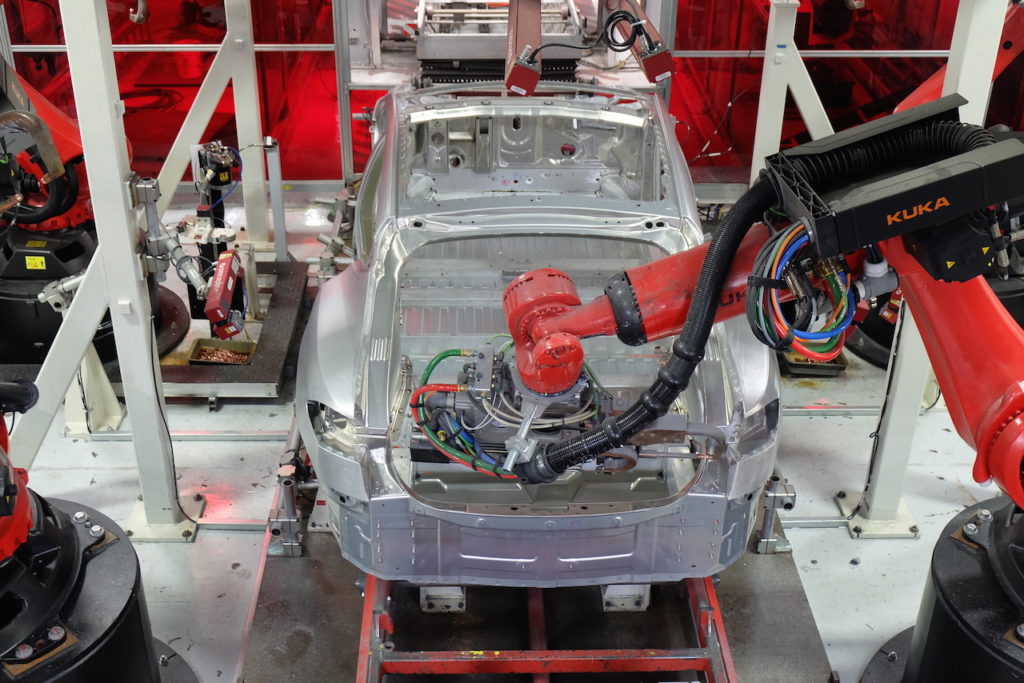
Birmingham is hosting a pair of business summits this week that showcase Alabama’s growing automotive and manufacturing industries, providing participants with high-level networking opportunities and one-on-one meetings. The conferences are the Aerospace Innovative Technology Summit (AITS), held May 7-9, and the Automotive Advanced Technology Summit (AATS), held May 8-9. Both events are taking place at the Birmingham-Jefferson Convention Complex, with 200 companies expected to participate. The Alabama Department of Commerce is among the sponsors of the summits, which feature workshops, presentations and business-to-business meetings. “The automotive and aerospace industries are major drivers of economic growth in Alabama, and these business conventions in Birmingham offer a pathway for companies from across the country and around the world to seek new opportunities and understand how their peers are utilizing and advancing the latest technologies,” said Greg Canfield, secretary of the Alabama Department of Commerce. “Besides companies from Alabama and multiple U.S. states, an international presence representing 11 different countries is here to participate,” he said. “These summits bring a focus on innovation, which is critical to growing and sustaining these manufacturing sectors and placing Alabama in a leading role for the latest technologies.” Focusing on innovation The Aerospace Innovative Technology Summit targets the aerospace, space and defense industries, all with a significant presence in Alabama. With a focus on new technologies being deployed in the sector such as 3D metal printing, digitalization of manufacturing and cyber security, the event aims to connect leading companies and participants in the sharing of ideas in the application and development of these innovations in their businesses. To kick off the aerospace conference, Canfield will provide an overview of the industry sector in the state. Other scheduled speakers include R.G. “Corky” Clinton Jr. of NASA’s Marshall Space Flight Center, Nick Bowman of GKN Aerospace and Jeff Chang of Lockheed Martin. The Automotive Advanced Technology Summit will focus on advanced manufacturing and new technologies at use within an industry growing rapidly in Alabama. Scheduled speakers include Mark Brazeal of Mazda Toyota Manufacturing USA, Tom Shoupe of Honda of America Manufacturing, and Brad Newman of ZF Chassis Systems in Tuscaloosa. Also speaking is Chuck Ernst, a former Honda Alabama executive who now serves as manager of the Alabama Robotics Technology Park, a unique training facility in Decatur. “It is an honor to have Birmingham chosen as the site for both of these conventions,” said Brian Jennings, vice president of economic development for the Birmingham Business Alliance (BBA). “It speaks to Alabama’s prominence in both the aerospace and automotive industries, and we look forward to bringing so many people together to foster continued growth of both industries.” Joining the BBA and the Department of Commerce in supporting the business conferences are the City of Birmingham, Jefferson County, the Birmingham Airport Authority, the Alabama Automobile Manufacturers Association and the Alabama Community College System. Mayor Randall Woodfin said Birmingham is the ideal location for the events. “Now, more than ever, Birmingham is focused on bringing high-quality technology jobs to our city. The summit gives a great chance to identify innovative partners that share our commitment to the next generation of manufacturing in the aerospace and automotive industries,” Woodfin said. This story originally appeared on the Alabama Department of Commerce’s Made in Alabama website.
Lockheed Martin’s Jason Crager named to Manufacture Alabama Board of Directors

Manufacture Alabama — the state’s only trade association dedicated exclusively to the competitive, legislative, regulatory and operational interests and needs of manufacturers and their partner industries and businesses —on Tuesday announced the addition of Jason Crager to the Board of Directors effective immediately. Crager, who serves as the Director, Lockheed Martin Pike County Operations, has more than 20 years of experience in various roles within Manufacturing Operations and Product Management at Lockheed Martin. “We are extremely pleased to have Jason come on in a leadership role,” said Manufacture Alabama President George Clark. “Just as Alabama’s manufacturing sector evolves, so does Alabama’s manufacturing trade association. Jason brings with him a certain insight into the aerospace and defense segments of Alabama’s manufacturing base that will be of great value to the association.” The Texas native started his career as a Production Technician at Loral Vought in Lufkin, Texas while completing his Bachelor of Business Administration degree in Business Communication and Legal Studies from Stephen F. Austin State University in Nacogdoches, Texas. “I’m honored to be part of a great group of leaders in raising the profile of Alabama manufacturing,” said Crager. “This state is well-recognized for its place in the industry thanks to Manufacture Alabama, and in this role I intend to add to those efforts to continue strengthening Alabama’s economy and workforce. In addition to Crager, Manufacture Alabama’s Board of Directors includes: Chairman David Carroll of Hunt Refining Company in Tuscaloosa Vice-Chairman David Hendrixson of Daikin America, Inc. in Decatur Treasurer Marty Parker of Packaging Corporation of America in Jackson Secretary Paul Vercher of United States Steel in Birmingham Mark Bush of SSAB North America in Axis Carl Gunter of International Paper in Prattville
Boeing investing in future growth at its Alabama operations
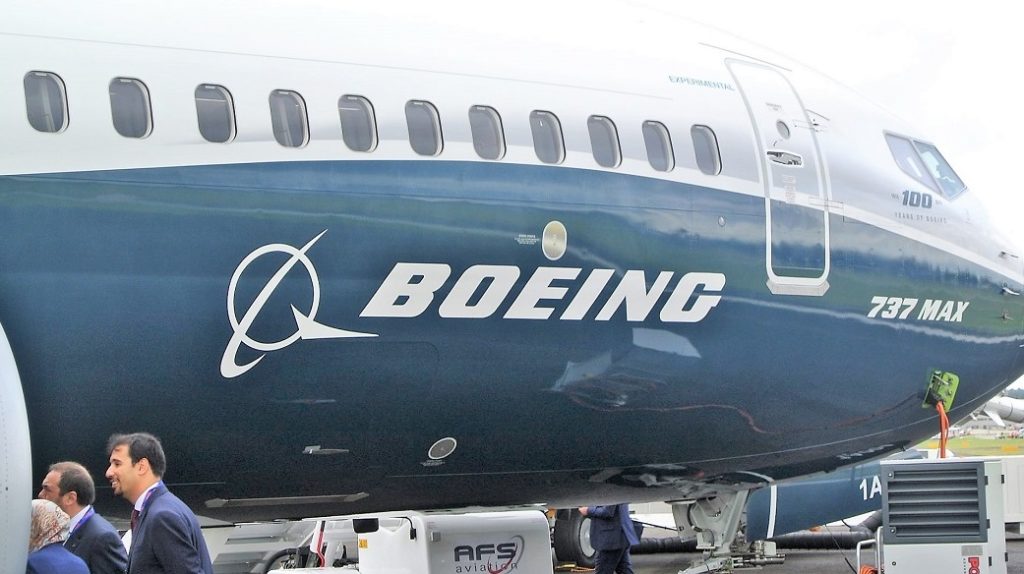
While aerospace giant Boeing grabs headlines with major deals at the Farnborough International Airshow, its Alabama operations are having a far-reaching impact on the company’s global business. Boeing workers in Alabama provide critical support and expertise in weapons systems, space exploration, advanced avionics research and more. One of the latest developments in the company’s 56-year history in the state is the expansion of its Patriot Advanced Capability-3 (PAC-3) missile seeker facility in Huntsville, which is taking support of its customers and warfighters to a whole new level. Meanwhile, Boeing is investing about $70 million in capital in Alabama to prepare its facilities for future growth. “It is an exciting time to work in aerospace in Alabama,” said Norm Tew, vice president and general manager of the Missile and Weapon Systems Division, and Huntsville senior site executive. “Boeing’s Alabama employees are designing, building and supporting some of the most advanced and most critical aerospace systems in the world, through our work on NASA’s Space Launch System, advanced air and missile defense systems, strategic deterrence systems, our engineering design centers and the many other projects and programs we support at our facilities in Alabama,” Tew said. “As the largest aerospace company in the state, we continue to grow our portfolio of work here and we’re making the investments to do so.” PAC-3 seeker The new PAC-3 seeker expansion is a 28,000-square-foot state-of-the-art facility with investment from Boeing, as well as its customers. Gov. Kay Ivey joined company officials in April to mark the completion of the project. “This facility houses the latest production and test equipment and gives us additional capacity required to produce PAC-3 seekers for our customer and partner, Lockheed Martin – ultimately helping support the growing needs of the U.S. Army and its allies for the PAC-3 missile capability,” said Boeing spokeswoman Jen Wollman. The Boeing seeker technology provides key target data to the PAC-3 missile guidance system, and the company has produced more than 3,000 PAC-3 seekers over the history of the program, which spans more than 20 years, she added. Boeing’s Alabama-made seekers provide active data to the PAC-3 missile, which enables it to acquire, intercept and destroy enemy ballistic and cruise missiles as well as hostile aircraft using hit-to-kill technology. The company invested $45 million to expand the Huntsville PAC-3 missile seeker production line in 2011, and last year workers produced the 3,000th seeker at the Alabama location. Alabama presence Boeing employs about 2,700 people in Alabama at two key facilities in Huntsville, in the Jetplex Industrial Park and at Redstone Gateway. The company generates an estimated $2.3 billion of economic activity in the state annually. Last year, it spent $606 million with nearly 200 suppliers, supporting about 18,000 direct and indirect jobs. In addition, Boeing and its employees contributed more than $1.6 billion to charitable organizations throughout the state in 2017. “Boeing has been a pillar of Alabama’s aerospace industry for more than half a century, buoyed by the skill and dedication of its Huntsville workforce,” said Greg Canfield, Secretary of the Alabama Department of Commerce. “The company continues to deepen its roots here in the state, setting the stage for even more groundbreaking research, developments and products.” Boeing’s core business areas in Alabama are: Missile and Weapons Systems: Includes Ground-based Midcourse Defense, designed to detect, intercept and destroy long-range ballistic missiles during their midcourse phase of flight, and Strategic Deterrence Systems, which integrate Boeing’s support of the U.S. Air Force’s nuclear deterrence mission. Space and Launch: The world’s largest satellite manufacturer, which also provides other space and intelligence systems and manages Boeing’s share of United Launch Alliance and United Space Alliance. Also includes Space Launch System, responsible for design, development, testing and manufacture of the core and upper stages and avionics for the nation’s next-generation human-rate rocket to take people and cargo to deep space and to the International Space Station. Boeing Global Services: Support services for U.S. Army helicopters. Huntsville Design Center: Includes a team of nearly 250 engineers that support a wide variety of programs, including military and commercial aircraft. Boeing Research and Technology: The Alabama research center houses about 300 engineers, scientists and technicians who are working on advances in avionics systems, composite materials, cybersecurity and other areas. Republished with the permission of the Associated Press.
Boeing expands Alabama PAC-3 missile seeker facility

Aerospace and defense leader Boeing marked the completion of a major expansion at its Patriot Advanced Capability-3 (PAC-3) missile seeker facility in Alabama’s “Rocket City.” Boeing officials joined military leaders, Gov. Kay Ivey and local officials at a ribbon-cutting ceremony for the 28,000-square-foot facility at 499 Boeing Blvd. in Huntsville. The expansion will enhance the company’s ability to produce, upgrade and sustain the PAC-3 missile seeker program. Boeing is adding 70 employees to its Alabama workforce as part of the project. “This is a proud moment for Boeing,” Jim Chilton, a Boeing senior vice president, said at the event. Boeing’s Alabama-made seekers provide active data to the PAC-3 missile, which enables it to acquire, intercept and destroy enemy ballistic and cruise missiles as well as hostile aircraft using hit-to-kill technology. Boeing invested $45 million to expand the Huntsville PAC-3 missile seeker production line in 2011. In June 2017, the company produced its 3,000th seeker at the Alabama location. The missile seekers made in Huntsville are delivered to PAC-3 prime contractor Lockheed Martin. The PAC-3 missile system is deployed with U.S. Army and Army National Guard air defense units, and it has been purchased by several international customers. Work on the new facility in Huntsville began in June 2016. Boeing impact Since arriving in Huntsville in 1962, Boeing has played a key role in building the nation’s defense and space programs in Alabama. It has long ranked as the state’s largest aerospace company, with more than 2,700 employees at two main facilities in Huntsville. “Boeing has been doing business in Alabama for more than 50 years,” Ivey said at the event. “A long time ago, Boeing found that Alabama is a good place to do business, especially in aerospace and defense.” U.S. Rep. Mo Brooks and Huntsville Mayor Tommy Battle both said the work being done by Boeing keeps the U.S. safe and protects the lives of soldiers deployed overseas. Core business areas for Boeing in Alabama include missile and weapon systems, the Space Launch System (SLS), an aerospace design center, and a research and technology center. “Boeing’s continued growth in Alabama is a testament to the company’s strategic vision, as well as the skillful execution by its extremely talented workforce in the state,” said Greg Canfield, secretary of the Alabama Department of Commerce. “Boeing’s innovative work in Alabama is critical to our nation’s defense and space programs, and the company has helped the state build a significant presence in an industry with a solid future.” Boeing’s financial impact on Alabama has been measured at $2.3 billion annually. Republished with the permission of the Alabama News Center.
Lockheed Martin receives $80 Million contract for missile defense targets
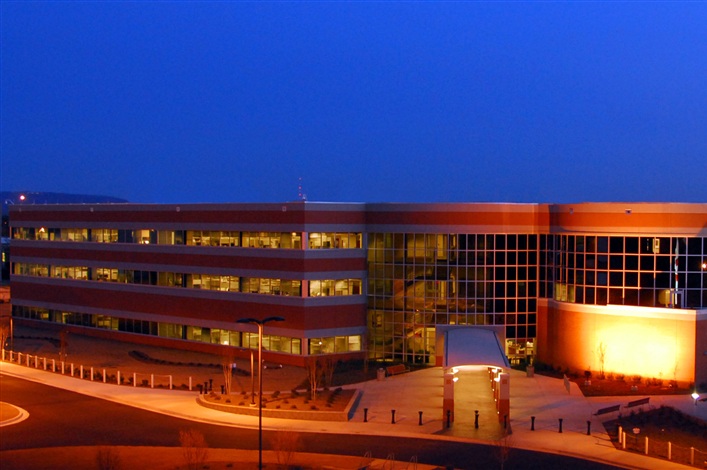
The Missile Defense Agency on Thursday awarded Lockheed Martin an $80.6 million contract to build and test modified ballistic re-entry vehicles and separation modules for missile defense tests that will be designed and produced in Huntsville, Ala. The company will be producing unarmed re-entry vehicles for target missile tests through 2022. The contract also includes opportunity for additional vehicles and mission support. “The re-entry vehicle is essentially the bullseye for an interceptor missile, and it is also one of the most complex parts of the target, in today’s environment, it’s incredibly important to test against threat-representative targets that look like enemy missiles, and we are proud to continue to provide that capability to the Missile Defense Agency,” said vice president of Missile Defense Programs at Lockheed Martin Space, Sarah Reeves. Huntsville native companies will be included on the project including: Dynetics, Inc. will provide the aeroshell structures, and Battelle will provide the hit detection system. “Instead of carrying warheads, modified ballistic re-entry vehicles carry sensors to measure the accuracy and effectiveness of the target, interceptor and missile defense system. Testing against a capable, threat-representative re-entry vehicle helps ensure the ballistic missile defense system is ready to detect and destroy enemy missiles,” Lockheed Martin said in a news release. Lockheed Martin is a long-standing defense company, whose Huntsville location will be celebrating 55 years of work within the Yellowhammer State in May. The company expanded it’s presence within the state last year with the opening of their new training facility in Troy, Ala. in September. The Huntsville facility is expected to employ over 240 people by 2020.
Governor talks Alabama aerospace growth at Paris Air Show
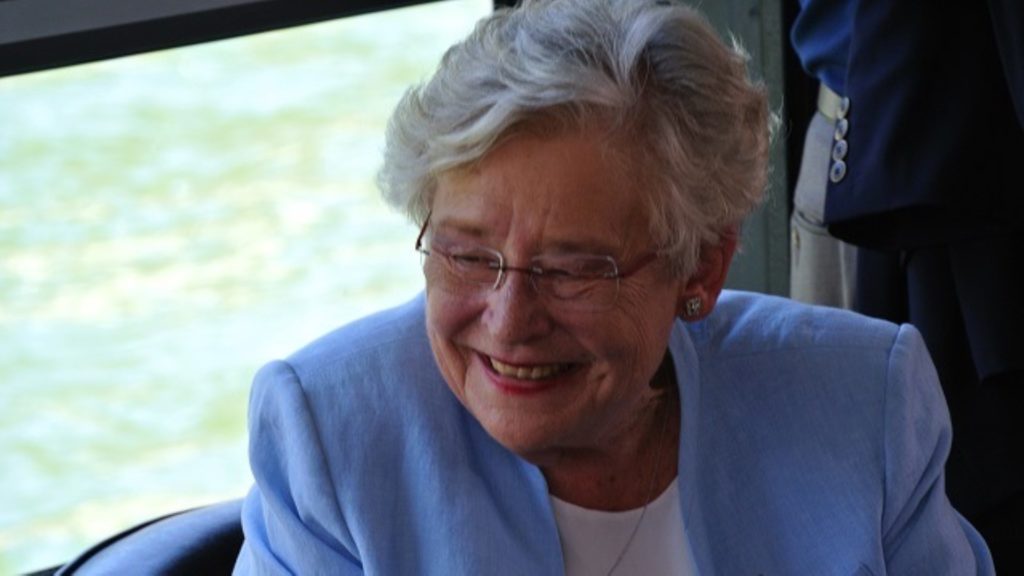
Gov. Kay Ivey and the Alabama team in France for the Paris Air Show connected with aerospace industry leaders at an exclusive gathering sponsored by a partnership that promotes the Gulf Coast aerospace cluster for long-term growth. The Aerospace Alliance’s event in Paris brought together delegations from Alabama, Mississippi, Florida and Louisiana with invited guests from aerospace companies and government agencies on the eve of the industry’s premier trade show. Ivey is leading an Alabama delegation at the Paris Air Show that includes business development specialists, government officials, university representatives and others. Gov. Kay Ivey speaks with Opelika Mayor Gary Fuller at the Aerospace Alliance event in Paris. (Made in Alabama) The Aerospace Alliance cruise on the River Seine gave Ivey her first chance on the Paris Air Show mission to talk business with high-level executives in the field and share her commitment to supporting aerospace industry growth in Alabama. Made in Alabama caught up with Ivey to capture her thoughts on what she wants the team to accomplish at the 52nd installment of the Paris Air Show, which started Monday at Le Bourget Airport. Made in Alabama: Why is it important for Alabama to be at the Paris Air Show? Gov. Kay Ivey: The aerospace industry in Alabama is thriving – and we want to see even more growth in this vital sector. At the Paris Air Show, we’ll get a chance to talk with many industry decision-makers in private meetings, telling them Alabama is open for business. It’s a perfect opportunity to tell them about our advantages. To make sure Alabama remains a leader in aerospace, we must be strategic and work on building the relationships that will bring more jobs and investment to the state. The Paris Air Show is the best place in the world to do that. MIA: What are your goals for the Paris Air Show mission? Ivey: The primary mission of Alabama’s economic development team at the Paris Air Show is to promote the state to aerospace companies from around the globe. I want to personally share with the leaders of these companies my commitment to make Alabama the ideal location for them. Recruiting companies like Boeing, Airbus, Lockheed Martin and GE Aviation has made Alabama a force in the aerospace industry. In Paris, we’ll be working hard to position Alabama for a new wave of growth. Aerospace is lifting off in Alabama, and we have to make sure it continues climbing. Arista Aviation CEO Rich Enderle talks with Alabama Gov. Kay Ivey at the Paris Air Show. (Made in Alabama) MIA: What specific messages will you convey at the Paris Air Show? Ivey: That’s easy. Alabama has a rich history in aerospace, going back to the Wright Brothers, who set up a flight school in Montgomery more than a century ago. Rocket scientists and engineers at NASA’s Marshall Space Flight Center in Huntsville made the moon landing possible. We have a great heritage. Today, Alabama has everything an aerospace company needs to succeed. We have the skilled workforce and top-rated training programs. We have a pro-business environment and a solid transportation infrastructure. For aerospace companies, we really have it all. MIA: Why do you want to see the aerospace sector grow in Alabama? Ivey: Aerospace in Alabama is all about high-level jobs, thriving opportunities, advanced technology and dynamic innovation. Growth in this industry will continue to propel Alabama forward, and is a sign to the world that Alabama is open and ready for businesses to invest in our state. As the former chair of the Aerospace States Association, I know how critically important this sector is across the nation. Alabama is home to 400 aerospace companies from 30 different countries. More than 83,000 Alabamians are employed in aerospace and defense. I want to see us build on the solid base of this industry. The growth prospects are good. We just need to keep working to bring home that growth – and the jobs that come with it. This story originally appeared on the Alabama Department of Commerce’s Made in Alabama website. Republished with permission of Alabama NewsCenter.
Donald Trump targets F-35, but aircraft means jobs in 45 states

President-elect Donald Trump is vowing to corral the “out of control” cost of the F-35 Joint Strike Fighter. But congressional Republicans and Democrats, aware of the tens of thousands of jobs the aircraft generates in 45 states, will be wary of any plans by Trump to cut the program. A Monday morning tweet from Trump targeting the F-35 doesn’t explain exactly how he’ll save billions of dollars in military purchases while also honoring a campaign vow to rebuild the armed forces. Once Trump is in office, he can propose deep cuts to the F-35 or even elect to cancel the program altogether. But Congress, not the president, controls the government’s purse strings and makes the final decisions about the budget. Built by defense giant Lockheed Martin, the nearly $400 billion price tag for the F-35 makes the program the Pentagon’s most expensive weapons acquisition ever. Despite the huge cost, the program has strong bipartisan support in Congress, where lawmakers view the aircraft as essential to national security. After Trump’s tweet, Lockheed Martin’s shares tumbled, wiping out nearly $4 billion of the company’s market value. The F-35 program made up 20 percent of Lockheed’s total 2015 revenue of $46.1 billion. U.S. government orders made up 78 percent of its revenue last year. “Whoever has this airplane will have the most advanced air force in the world. That’s why we’re building the F35. That’s why it’s important to not only the U.S., our partners and our partners like the Israeli Air force to have this airplane,” said Jeff Babione, general manager of the F-35 program, at a base in Israel. Israel and several other U.S. allies are also buying the F-35, expanding the program’s international footprint. Defense Secretary Ash Carter visited Israel on Monday as Tel Aviv received the first two next-generation F-35 fighter jets that will help preserve the country’s military edge in the volatile Mideast. The F-35, which uses stealth technology to avoid being detected by radar, is being built in different configurations to be used by the Air Force, Navy and Marine Corps. The Navy’s version, for example, is designed to take off and land on an aircraft carrier. Current plans call for the United States to buy nearly 2,500 F-35s. Close to $13 billion will be needed annually between 2016 and 2038 to hit that procurement number, according to the Government Accountability Office. While the F-35 had massive budget overruns early on, the cost has stabilized and even dropped a bit following tough negotiations between the Pentagon and Lockheed Martin, according to Todd Harrison, a defense budget expert at the Center for Strategic and International Studies. “Trump is unlikely to squeeze more blood out of this rock,” Harrison said. Lockheed said that it has worked to lower the price of the F-35 by 60 percent and expected the aircraft to cost $85 million each in 2019 and 2020. But the company’s estimate appears to omit the price of the engine and the cost of development. When those elements are added in, the cost per F-35 in current-year dollars is closer to $138 million, according to Harrison. Companies from 45 states are involved in the F-35’s production, with Texas, Georgia, California, Arizona and Florida playing the leading roles in testing and manufacturing the jet fighter. The company is teamed with more than 1,250 domestic suppliers to produce thousands of components ranging from highly sophisticated radar sensors to parts of the aircraft’s fuselage, according to Lockheed Martin. Overall, the F-35 program is responsible for more than 146,000 U.S. jobs, the company said. The Lockheed Martin plant where the F-35 is being built is located in Texas Republican Rep. Kay Granger‘s district. She’s vice chair of the defense appropriations subcommittee. Rep. Mac Thornberry, the Republican chairman of the House Armed Services Committee, represents the district next door to Granger’s. In a statement Monday, Granger hailed the F-35 delivery to Israel, calling the aircraft “what we need to keep our two countries safe in these dangerous times.” Thornberry’s committee has supported buying more F-35s than the Obama administration had asked for in its budget request. The F-35 will replace an aging inventory of U.S. aircraft that many lawmakers believe are becoming increasingly unsafe to fly. Claude Chafin, a committee spokesman, said Thornberry “shares the president-elect’s determination to have the Pentagon get weapons in the hands of our troops faster, while being better stewards of the taxpayer dollar.” The tweet on the F-35 marks the second time in a week Trump has blasted U.S. aircraft spending. Last week, he tweeted that costs to build new presidential planes by Boeing Corp. were “out of control” and ended the tweet with “Cancel order!” Republished with permission of The Associated Press.
Alabama business roundup: Headlines from across the state

Here’s a roundup of some of the top weekend business headlines from across the state: AL.com: Craft brewers: Alabama laws stifle growth of burgeoning beer industry Like many of Alabama’s close to three dozen craft brewers who stepped into an industry barely formed, Jeremy Pate is above all optimistic. On the Dothan farm where his grandparents used to grow corn and peas, Pate started Folklore Brewing & Meadery a few years ago, offering the only locally produced beer in the Wiregrass region. There he has lots of room to grow, but Pate says beer laws in the state need to catch up first. Pate, 40, believes the existing regulations, which restrict breweries from selling beer directly to customers other than through a licensed retailer, are not broad enough for his business to thrive. “There are beers that we do not distribute, that we do in very small scale, experimental nature,” he said. People often want to buy those, or another beer that’s to their liking. Unlike many states, Alabama law prohibits brewers from selling it — either in a keg, bottle or glass jug — to-go. Pate started by making a simple wheat ale when he opened in 2013. Wiregrass Wheat, he called it. Today, you can find one of his beers in restaurants and stores in Enterprise, Ozark and around Opelika and Auburn. Revenue from retail distribution is great, but not as lucrative as the cash that comes from residents and beer aficionados in search of something new to drink in their taproom. “The profits on a bottle that we sell out there in the market is miniscule compared to what we get by the pint,” Pate said, “so the limiting factor is how much beer came one person safely consume at a brewery?” Fighting ‘history’ Pate is not alone in his frustration with the state. Beer makers in north Alabama and down along the Gulf Coast have long agreed lawmakers could do better by the burgeoning industry. And there have been efforts since 2009 when a law allowing beers with a higher alcohol content to be sold was passed. But it was a relatively small change in the grand scheme of things. “It was not until the Brewery Modernization Act that any breweries wanted to be in Alabama, period,” Pate said. That law was passed in 2011, and aside from a bill allowing 22-ounce bottles known as “bombers” to be sold by breweries, expanding regulations for the industry has stopped. Brewers, who sometimes struggle to eke out a profit, say this has put a vise grip on available business opportunities and limits their ability to compete. Meanwhile, there’s about $23 million in unrealized economic activity in the beer industry, a figure that could grow with more relaxed beer laws, according to a recent study by Jacksonville State University. Like many, Pate knows there is more money to be made with off-premise sales, but in December 2014 he started bottling “bombers” for distribution. “That’s the only way that we have any chance to grow because of the limited laws,” he said. “And even at that rate we’re going to have to grow slower than other breweries in other states.” Using what’s known now as the “three tier system,” lawmakers placed in between the manufacturer and retailer an independent wholesaler to keep one company from controlling each stage of the process: production, distribution and sales. Beer and alcohol production was a different industry in 1933. The three-tier law never anticipated a surge in craft beer production several decades later, mainly by small upstarts, not dominant corporations. But “history” is the chief opponent to changing the old law, said Jason Wilson, current president of the Alabama Brewers Guild and founder of Back Forty Beer Company in Gadsden. In Alabama, and more generally in the Deep South, Wilson said changing “a lot of the stereotypes and misconceptions that are associated with alcohol” is not easy. Legislative challenges As a case in point, look to the recent Legislative session. A number of proposed solutions filtered through the statehouse in Montgomery. The largest bill, which would have allowed growler sales for breweries and brewpubs, and given them the option to participate in entertainment districts, failed. A trimmed down version of that bill also died. And a last-ditch measure that would have permitted just to-go beer sales didn’t come up for a vote. The one bright spot was the creation of the Alabama Alcoholic Beverage Study Commission, which has the task of making the state’s laws consistent with others around the country. Wilson said his hopes for the group “are a little bit grander” than simply identifying policy outcomes. The commission, which is hosting public hearings this month in Alabama, has “a pretty promising mission statement,” he said, “– now whether we can accomplish those things this year, I don’t know.” The Guild has already offered the commission a jump start, creating a list of proposals that outline the organization’s objectives. At least one of those, the creation of a single craft brewer license for brewpubs and breweries, may cause some in the industry to pause. “That means everybody is operating under one license, and I would have to revert back to ABC to see if you can actually regulate under those types of circumstances,” said Donna Alexander, executive director of the Alabama Wholesale Beer Association. Overall, she said craft brewers do not pose an existential threat to the beer wholesalers she represents. Limited opportunity In the meantime, some business opportunities are slowed. And an industry that produced close to 40,000 barrels of beer last year is moving at half speed. Some feel it more than others. Making about 250 barrels of beer every year, Druid City Brewing in Tuscaloosa is up against a real demand crunch, said co-owner Elliott Roberts. “We’re actively exploring expansion plans, but where we have trouble is, well, money,” Roberts said. Nailing down the right real estate has also been a challenge, but primarily it comes down to creating more revenue.


